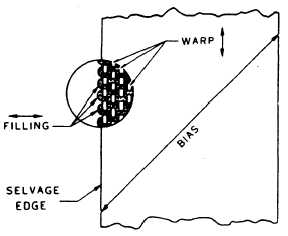239.367A
Figure 10-1.—Textile terms.
Selvage and Raw Edges
The selvage edges of material, as shown in
figure 10-1, are the edges of cloth, tape, or
webbing that are woven to prevent raveling. When
the material is cut, the resulting edge at the cut
is referred to as a raw edge.
Warp
There are threads that run lengthwise of the
cloth parallel to the selvage edge. If there is a
difference in the strength of the warp and filling
threads, the warp threads are usually stronger,
because they form the framework for the material
and support most of the strain during the weaving
process. Figure 10-1 shows both warp and filling
threads.
Filling
Filling is also referred to as a woof, weft, or
pick. It is the threads that run crosswise to the
cloth as it comes from the loom. This term is not
to be confused with filling in the sense of sizing,
which means the addition of substances that give
body or decrease porosity of the material. Warp
and filling threads must be determined in pattern
layout because patterns (unless otherwise stated)
are always cut with the warp and filling.
Weave
The weave is an interlacing of two sets of
threads (warp and filling) to form a specific
pattern. The manner in which the material is
woven or constructed affects many of the cloth
properties,
such as tensile strength, air
permeability, and elongation.
Bias
A bias is a diagonal line of a cut, a fold, or
a seam across a piece of textile material at an angle
of 45 degrees to the direction of the filling threads
in the material. Bias construction is used to save
material, prevent tearing between sections, and
provide elasticity where it is a requirement for a
satisfactory performance of the article. The bias
direction of the fabric has a greater stretching
quality than the straight direction. A bias cut is
shown in figure 10-1.
Tensile Strength
The force required to break a material is called
tensile strength. The tensile strength of a fabric
is stated in pound-per-inch width for warp and
filling. The tensile strength of webbings and tapes
is stated for the full width.
Cloth Weight
The cloth weight is the weight of a cloth, or
fabric, in ounces per square yard. All fabrics have
a designated cloth weight. For instance, a square
yard of cotton duck may weigh 8 ounces;
therefore, it is called 8-ounce duck.
CONSTRUCTION FEATURES
AND USES OF VARIOUS TEXTILE
MATERIALS
If a cigar ash burns a hole in your tweed
jacket, you will not patch it with a piece of velvet
material. If a life raft needs repair, you will not
use tweed fabric to repair it. Or, if an NES 12
canopy needs repair, you won’t use 7.25-ounce
nylon duck. If a repair is to make an item usable,
must use like material.
In the not too distant past we were limited to
natural fibers as a source for our fabrics and
associated materials; but today, with the advent
of synthetic fibers,
we can enjoy their
improvements in some respects over the natural
fiber. Currently the natural and synthetic fibers
have their respective advantages and
disadvantages. Because you cannot use synthetic
or natural fiber materials exclusively, you must
decide which one best serves your purpose. There
10-2

